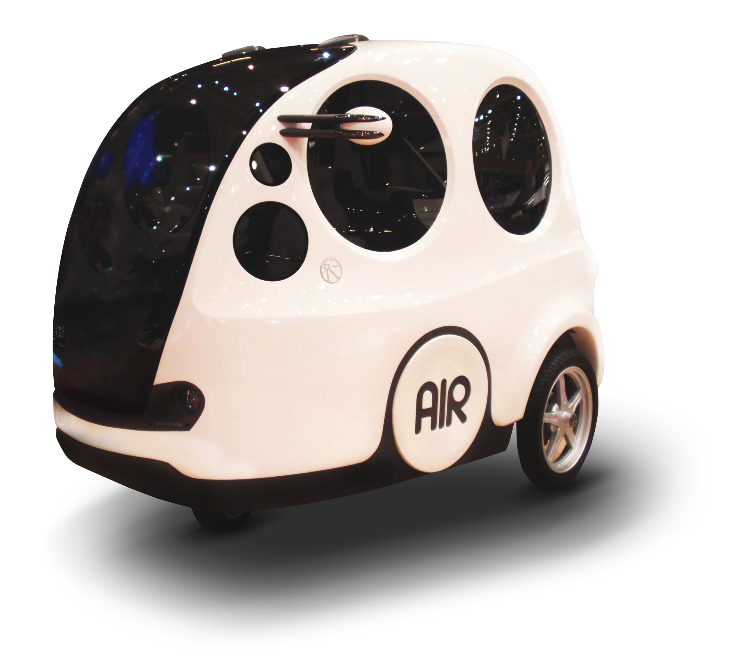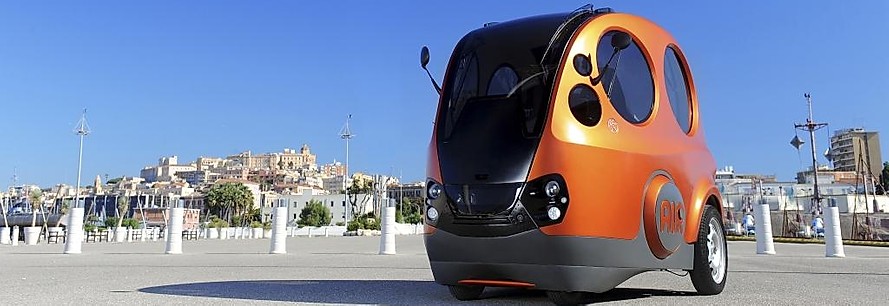Source: greenfuture.io
Published: March 10, 2017
The Airpod is a zero-pollution, air-powered car that wants to change transportation.
At 4 a.m., bleary-eyed and barely awake, I spoke with Cyril Nègre on the other side of the world. He was Skyping with me from France, where the company established by his father, Motor Development International (MDI), was quietly working on a form of transportation technology that could change the way we navigate our cities.
MDI’s product is an air-powered car called Airpod, and it looks like something that belongs on The Jetsons — half smart car, half futuristic bubble-cycle. If you’re a fan of Shark Tank reruns, you may have seen the April 2015 episode that featured Pat Boone and Ethan Tucker pitching the Airpod. The duo eventually secured $5 million in investment funds for Zero Pollution Motors (ZPM), the US licensee for MDI’s technology.
Since then, news has been scant about the Airpod in the US. ZPM’s Facebook page hasn’t been updated since April, and even then, the post was about SpaceX’s successful Dragon launch.
When I connected with Cyril, I expected to discuss some of the delays facing ZPM’s US development. I didn’t expect to see news on MDI’s website the next day about the passing of Cyril’s father, Guy Nègre, the engineer who wanted to help save the planet.
Here’s the status on Airpod — and the innovations that are close to becoming a reality.
The Air Powered Car: What Is An Airpod?

Guy Nègre — inventor, car enthusiast, staunch environmentalist, and former Formula 1 racing engineer — loved the freedom afforded by cars. Back in 2002, he told Reuters, “I’m a firm believer that the car means freedom and people will not give up freedom, no matter what it’s doing to the environment … So the only way to save the planet is to come up with a car that doesn’t wreck it.”
The Airpod is MDI’s solution to planet-wrecking transportation. Currently in its second iteration, the Airpod 2.0 is a four-wheel vehicle with an 80 kilometer per hour (50 mph) maximum speed and 120 kilometer (75 mile) range. “It’s possible to extend the range using a dual engine mode,” Cyril tells me, “and with half a litre of petrol plus the air tank, we will be able to achieve around 400-450 kilometers (249-280 miles) in range.”
Naturally, the Airpod’s attention-grabber was its engine that runs on compressed air — so why incorporate an engine that can also use petrol? “The first [Airpod] was good for car sharing or renting cars, but not for private people,” Cyril says. “So we decided to modify the car, and now, we are in the process of building the molds for first production.”
According to ZPM, a single Airpod costs slightly over $10,000. It takes just three minutes to charge from a mobile or gas station air compressor, and it costs approximately $2.00 to fill the tank. Those numbers are potentially game-changing for drivers commuting around major cities — and for cities that want low-cost, high-efficiency fleet vehicles.
Who Is The Airpod For?
I asked Ethan Tucker, VP of Marketing at ZPM and Shark Tank alum, about the Airpod’s audience — is it for consumers, or is it for the private sector?
“The Airpod is intended primarily for urban use as low-speed utility vehicles,” Tucker says. He explains:
“We plan to sell fleets for city postal deliveries, park vehicles, traffic cops, meter maids, taxis, airport cargo, prison complexes, and public rental programs like city bicycles. Also, we would like to sell small fleets to high-rise apartment buildings and condos for tenant local travel, similar to the NEV model (Neighborhood Electric Vehicles). We consider the Airpod to be not only disruptive as green transport and new energy storage technology, but also to change the entire concept of local travel.”
Tucker framed the Airpod as a “disruptive,” a term that refers to an innovation that creates a new market. And like all new innovations, Airpod’s evolution has seen its fair share of fits and starts — it was originally certified in 2010, but has since faced a series of setbacks that have delayed production. “We signed contracts with some people who did not respect their contract and their financial issues,” Cyril explains.
Those delays are over, according to Cyril and Tucker.
Producing An Air Powered Car
“The first production will start in Sardinia,” Cyril says. “We need about two to three months to certify the new Airpod. The first Airpod that will be sold will be in January or February next year. It’s been very long because of many things,” he admits, “but now we are in the process of applying everything that has been blocked.”
What about the US? As MDI’s licensee in the US, ZPM was originally going to start production in Hawaii, which was partially chosen for its size. “It’s good to have one plant there that is going to produce between 1,000 and 2,000 cars per year,” Cyril says. “We have to see whether the Airpod is accepted by the market there because it’s a very small car … It’s a first step. We are taking our time at MDI because of certifications and strategy, but now it’s time to put something on the market.”
But according to Tucker, market interest is already promising, and ZPM may set its sights beyond Hawaii. Tata Motors is an auto manufacturing company in India, and “as a result of Tata Motors’ successful proof of concept testing for their Nano with MDI’s compressed air motor (they are scheduled for production early 2017) and the public enthusiasm for the Airpod from Shark Tank and other media, we no longer feel the need to begin in Hawaii,” Tucker says. He adds:
“We now have serious interest from a city in the Midwest that would like to build an Airpod factory, including land and tax incentives, and private equity. If all goes well, we hope to begin production by early 2017.”
After years of development, the Airpod is finally making headway — and MDI and ZPM are charging headlong into the future.
The Truth About The “MiniCat”
One final setback needs to be addressed, though: on MDI’s Wikipedia page, a series of updates under “Company History” paint a troubled picture. In 2013, “the air-powered “MiniCat” was promised to be on sale in India before the end of 2013” from Tata Motors. The line “MiniCat has yet to be produced” is repeated from 2014-2016.
I asked Cyril about this line — and was surprised by what he shared.
“There have been a lot of misunderstandings because a lot of newspapers and people and media have said that there will be some MiniCat or some air cars by MDI in India. It is not true,” Cyril explains. “We never said that there will be any MiniCats in India. The deal we have is that Tata Motors has bought the exclusive licence of our Indian technology. But they’re going to produce their own car, not MDI cars — their own cars using our engines.”
Driving Toward A Better Future
Cyril views the Airpod as just the beginning: he believes that energy management and energy storage using compressed air technology is one of the biggest potential markets for MDI. “The advantage of compressed air is that you can store energy, and if you are able to do an expansion of this air with a very huge efficiency as we are doing, then you can manage the storage of energy.”
Guy Nègre described himself as a motorist who also cared about the state of the planet. Through MDI’s development and production around the globe, his vision of a planet-friendly car is finally on track.
“We have innovated for so many years that now, we are in the process of applying things. And that’s the main transformation of the company,” Cyril said. “This is very important because my father was the one that innovated and did the research and development, and now, we are going to apply everything that he has developed.”


